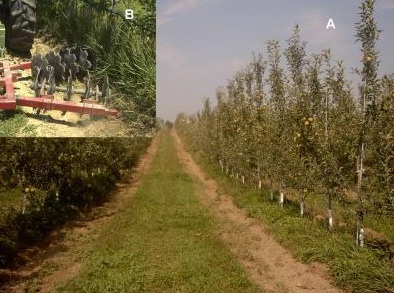
Features
Production
Research
Organic apple orchard floor maintenance techniques
September 22, 2009 By HortScience
 WEB EXCLUSIVE
WEB EXCLUSIVE
Organic apple orchard floor maintenance techniques
Successful organic apple farming literally starts from the ground
up.
Sept. 22, 2009, East
Lansing, MI – Successful organic apple farming literally starts from the ground
up.
Maintaining a healthy
orchard floor is the key to preventing weeds and keeping soil healthy. Logically,
finding effective methods to increase production and marketability of organic
apples is critically important to growers who have to deal with pests and
disease without the use of conventional tools available to nonorganic growers.
 |
|
| This is the "Swiss Sandwich System" in Golden Smoothee orchard in Clarksville Experimental Station, Mich. |
Dario Stefanelli of
Michigan State University’s Department of Horticulture led a study to evaluate
three types of rootstocks of Pacific Gala apples. Published in HortScience, the
study compared three methods of orchard floor maintenance.
The first was an alfalfa
hay mulch treatment, applied by hand in the spring and fall, to prevent weed
growth and maintain soil moisture. Drawbacks of this method include expense,
maintenance, the risk of rodent damage, possible nutrient leaching, and
incubation of some weed species.
The second treatment was a
flame burning technique in which a propane burner was used to heat the weeds
under the tree canopy. The cost of this method was low, however the risks of
fire, branch injury, and damage to plastic irrigation systems increased.
The third method is known
as the Swiss sandwich system, which leaves a strip of vegetation to grow
naturally in the tree row with two shallow tilled strips on each side. The
grassy strip offers insects a space to live without bothering the trees and
acts as ground cover, which improves soil condition and adds nutrients. The
tilled strips help to reduce competition for water and nutrients. And, because
there is no need to mow, this method is easy to maintain. However, this method,
without additional fertilization, resulted in less suitable growing conditions.
No differences were noted
between rootstocks with the alfalfa hay mulch treatment, though it did improve
the appearance of the trees. It also created the most favorable soil conditions
for growing Pacific Gala trees. Trees on the Supporter 4 rootstock had the
highest growth values, while there were no significant differences between the
other two rootstocks. Rootstock was not a factor in crop levels of
mulch-treated trees. The M.9 RN 29 rootstock was the most productive using the
Swiss sandwich system and the flame treatments. The other two rootstocks'
results were the same for both systems.
According to Stefanelli,
the results suggest M.9 RN 29 and the low-cost (Swiss sandwich system) are the
most suitable combination that should be considered by growers who want to
plant Pacific Gala under organic protocols in Michigan and related climatic
regions.
The complete study and
abstract are available by clicking here.
Print this page